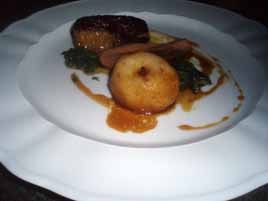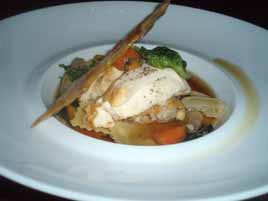
Note: Colicchio & Sons closed in September 2016 after six years in business. Tom Colicchio did not state his reasons, but he told The Times that “the last couple of years had been difficult for the restaurant.” Oddly, he also said that this was “the first restaurant I actually opened and closed,” having forgotten Craftsteak, the previous restaurant to occupy this space.
We did not think Colicchio & Sons deserved the three stars that Sam Sifton gave it.” To be fair, Tom Colicchio is good at running restaurants, and the place may have improved over time. Either way, Colicchio & Sons had been out of the media conversation for the last several years. It would not surprise me to learn that bookings were down.
*
I have often said that steakhouses are practically the most fool-proof restaurant concept that there is. Well, practically. Tom Colicchio proved that even a smart guy can botch a steakhouse, when he opened Craftsteak in 2006. Reviews were not good, and Colicchio was charging at least $10 a steak more than the going rate in Manhattan. A steakhouse can get away with those prices, as the BLT franchise has shown, but the steaks have to be great. Craftsteak’s often weren’t.
Late last year, Colicchio closed Craftsteak, and after the briefest of make-overs, re-opened as Colicchio & Sons. The majority of a $400,000 renovation budget was spent on a new wood-burning oven where the Craftsteak raw bar used to be. The format is startlingly similar to Gramercy Tavern, where Colicchio was founding chef. There’s a casual front room, where reservations aren’t taken, and a more expensive formal dining room—although it is not that formal, as anyone who has been to Craftsteak will recall.
The name is a bit of a dodge, as Colicchio’s sons are too young to work in a restaurant kitchen, or indeed anywhere. He has explained in various interviews that the restaurant is an attempt to get back to his culinary roots. Here, he serves composed plates, as he did at Gramercy Tavern, rather than the à la carte family-style dishes of the Craft restaurants.
The food in the dining room is expensive, with appetizers $12–22 and entrées $27–36. (The more rustic “Tap Room” has dishes ranging from $9–23.) That’s less than you would have spent at Craftsteak, but still well above mid-priced. At this tariff, the food needs to be terrific. As so often happens, our appetizers lived up to the hype, but the entrées didn’t.


Our meal began with excellent parker-house rolls served in a cast-iron skillet, a feature wisely held over from the Craftsteak days. White Bean Agnolotti with Chorizo, Pork Belly and Octopus ($19; above left) and Foie Gras Torchon with Persimmon and Walnuts ($22; above right) were just about worth what we paid for them.


Chicken “Pot au Feu” ($34; above left) reads well on the menu, but it was a disaster. We noted that an nearby table had ordered this dish, and it arrived cold. Sure enough, ours did too. The fault seemed to lie with the consommé poured tableside. When we complained, they whisked the plate away, but they just put it under a warmer and brought it back to us, this time with no consommeé added in our presence. After all that, the chicken was still lukewarm, and frankly it would not have been a $34 dish even if it were done perfectly. Padma and Gail would have told Tom to pack up his knives and go.
Roasted Rabbit ($32; above right) was at least done correctly, but I’d say there was a $5–10 “Colicchio premium” in the price. Entrées north of $30 need to rise above the routine that just about any chef or restaurant could do. This isn’t a dish that would win Top Chef.
 The wine list features an inventory for high rollers held over from Craftsteak, with plenty of bottles in three and four figures. But the sommelier told us that they have been adding less expensive choices. I found a wonderful Douro at $44, obscure enough that most restaurants wouldn’t even have stocked it.
The wine list features an inventory for high rollers held over from Craftsteak, with plenty of bottles in three and four figures. But the sommelier told us that they have been adding less expensive choices. I found a wonderful Douro at $44, obscure enough that most restaurants wouldn’t even have stocked it.
The service was better than you would expect for a three-week-old restaurant, though we assume that most of the staff was retained from Craftsteak. However, there was an uncomfortably long pause between the appetizers and the entrées.
We assume that Colicchio still fancies himself a three-star chef. For now, at least, Colicchio is in the house most evenings, along with Craft chef de cuisine, Damon Wise, and the former Craftsteak chef de cuisine, Shane McBride. That’s a lot of talent in the kitchen. Now they just need to deliver.
Colicchio & Sons (85 Tenth Avenue at 15th Street, Chelsea)
Food: *½
Service: **
Ambiance: *½
Overall: *½

 Wednesday, February 24, 2010 at 02:19PM
Wednesday, February 24, 2010 at 02:19PM  Tanoreen in
Tanoreen in  Review Recap
Review Recap 




























